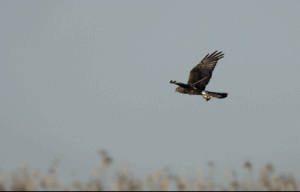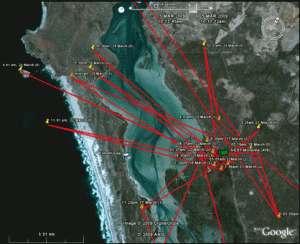Satellite-tracking Black Harriers in South Africa (Update March 2009) By Rob Simmons

A pilot study of the dispersal and behaviour of satellite-tagged Black Harriers Circus maurus was forged between Natural Research and Rob Simmons of the FitzPatrick Institute, University of Cape Town in 2008. Black Harriers are globally Vulnerable species with an estimated population of only 1000-2000 birds. Their breeding ecology and threats have been intensively studied in a 10-year programme run by Simmons and Andrew Jenkins, with their students focussing on the effects of habitat fragmentation and the utility of Black Harrier as indicators of biodiversity in the global biodiversity hotspot in the Western Cape of South Africa.
What is unknown is (i) where they go in the austral winter and (ii) if the movement and survival away from core breeding areas is influencing their low population numbers.
The pilot study using 2 breeding birds – one male and one female – was initiated in October 2008 as both birds finished breeding. The female (Charlize) showed minimal movement from her nest and roost area until January when she moved 90 km north to old farmland and natural vegetation where she was located (until March 2009). She is now back in her old breeding haunts. The male (Motlanthe, shown below carrying prey to his young), has remained in his breeding area but showed large movements unrecorded in breeding harriers before.
Relative to the maximum 3 km recorded for radio-tagged birds and sightings of wing-tagged birds, Motlanthe averaged 11 km foraging trips in October . This expanded to maximum records of 30, 40 and once 50 km from his nest. Like previous studies he remained within natural heath-like habitat, largely avoiding farmland. Night-time movements of the adult male Black Harrier over the period 17-23 March 2009. Orange marks indicate locations with an accuracy < 1km, indicating he moved at least 10 km from his roost area during the night.

The greatest surprise came from night time readings showing that the male has been highly active on three occasions when Argos readings came at night. The latest movements indicate a roost site near his old (successful) nest and movements throughout the night up to 10 km from the roost. On two such bouts while he had dependent young the nights were brightly moonlit. However, on the third occasion in mid-March 2009, there was a new moon and he was apparently moving in virtual darkness! The best guess as to his activity is that he is hunting gerbils that are nocturnally active, but further research is required.
It is hoped that by satellite-tracking birds away from these core breeding areas we can record large scale dispersal movements into Namibia where birds are regularly sighted in the austral winter. What they are eating and how well they survive remains to be seen.
R.E. Simmons, Cape Town 3 May 2009.
This work is funded and supported in a collaboration between Natural Research (UK), Hawk Mountain (USA) and the FitzPatrick Institute (RSA). Rob Simmons is grateful to Drs Mike McGrady and Ruth Tingay, and Dr Keith Bildstein for support.”





Dear Rob!
The nocturnal movements of the Black Harriers are highly interesting, congratulations to these results! Is it possible, that other circus species do also hunt during night time? Is there a connection between the “face mask” (the position of the feathers around the ears) and better hearing capabilities?
Thanks in advance,
best,
Marion
Hi Marion,
The only other evidence I know for nocturnal behaviour among the harriers is that Northern Harriers (C cyaneus hudsonius – or just C. hudsonius as I prefer given their genetic separation) are known to migrate at night. I cannot give you a reference for that though…. just one of those things one reads, stores and forgets where reported! Keith Bildstein at Hawk Mt may be the best person to ask if you want to follow it up. Their facial masks are known to assist in capturing unseen prey (Aussie work) but that won’t necessarily help them orientate while migrating.
Another person to ask is Chis Trierweiler who subscribes here and has new data on the migration of Montagu’s from Europe to the Sahel in Africa…. she would know if her birds migrate or hunt at night.
And of course pellet remains of strictly nocturnal mammals (e.g. gerbils here in South Africa) would help resolve how often it found in various raptors.
One last comment – there are remains of Sprinhares in Bateleur (Eagle) prey and they (the hares)are strictly nocturnal, so nighttime hunting may not be restricted to the harriers!
thanks for your interest
Rob
Hi Rob,
after months of silence my late thank you for the information! I just didn’t notice that you answered my question. Better late than never, thanks again,
best, Marion